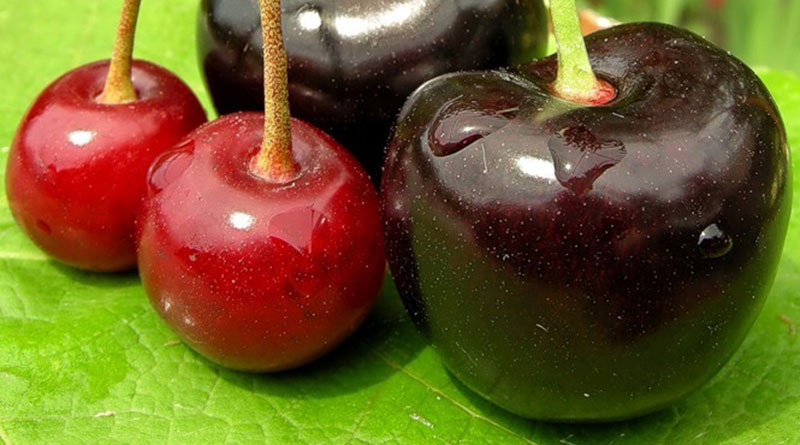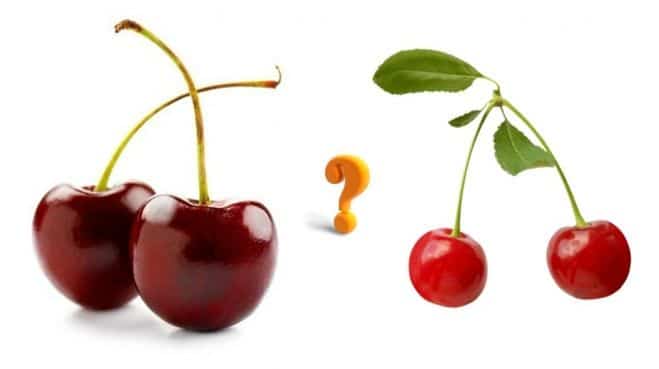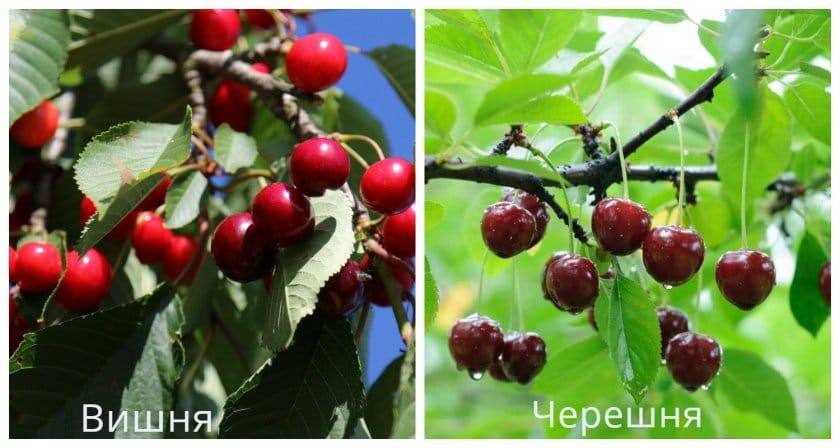How do cherries differ from sweet cherries and how to correctly distinguish between these trees and their fruits
Sweet cherries and cherries have similar fruits, but differ in taste and biochemical composition. Sweet cherries are more suitable for fresh consumption, as they have a sweet taste without sourness, but an unsaturated aroma. Cherries are used mainly for processing due to their rich aroma and noticeable sourness, which covers the sweetness. If it is not difficult to distinguish the fruits by taste, then inexperienced gardeners may have problems identifying them by external signs, since it is extremely difficult to distinguish large cherries from sweet cherries. Let us consider in detail how to distinguish berries from each other based on fruits and trees.
The main differences between cherries and sweet cherries

Cherry and cherry - these are two different species of the same genus Plum. It is believed that cherries appeared earlier and grew wild, and cherries were bred from them.
Attention! What is the difference between cherries and sweet cherries? In fact, there are many differences: botanical characteristics of plants, taste and composition of fruits, requirements for cultivation.
The fruits of the trees are visually similar. Without seeing the whole tree, it is easy to confuse the berries with each other. However, the plants themselves differ.
Taste and aroma
It is not difficult to distinguish cherry and sweet cherry fruits by taste. Cherries have a rich sweet and sour taste, and the sourness is very pronounced. Therefore, most people prefer to eat such fruits with additional sweetener.
Sweet cherries, practically without sourness. The taste is less intense.It does not need additional sweeteners, as it contains a large amount of sugar. Cherries have a rich aroma, while sweet cherries have virtually no smell. Its fruits are more fleshy, and cherry fruits are juicy.
Cherries are consumed mainly fresh on their own or as an ingredient for desserts. Jams and compotes from berries are rarely cooked, as they turn out to be unflavoured and cloyingly sweet, almost colorless. Cherries are sometimes used as a filling for pies with other, more flavorful additives.
Attention! The pits of cherries and sweet cherries contain the glycoside amygdalin, which in the presence of water breaks down to form hydrocyanic acid, a toxic substance that can cause severe poisoning. However, heat treatment in the presence of sucrose leads to the decomposition of hydrocyanic acid.
Cherries are often used for processing. Aromatic compotes, jams, confitures, and marmalades are made from it. The fruits are canned, dried, frozen, and added to baked goods, cakes and other desserts. The blanks have a rich red color. Cherries are rarely consumed raw without sweeteners: they are too sour for that.
Appearance of berries

Cherries and sweet cherries look similar, but there are differences between them. What characteristics can be used to distinguish fruits are described in the table:
| Parameter | Cherries | Cherry |
| Color | From light yellow to burgundy. There are varieties with yellow, orange, red, pink and burgundy berries. Some are unevenly colored (one side is pink or red, the other yellow). | From orange-red to dark red. Always colored evenly. |
| Form | Flattened on both sides, round or oval. | Ball-shaped. |
| Dimensions | The diameter reaches 2.5 cm.The weight of one berry is within 7–12 g. | On average, the diameter is 0.5–1.5 cm. Weight is 3–7 g. |
| How are they formed | Formed in whole brushes. | Formed in pairs. |
| Pulp | Lighter than the shell. Quite dense. | Usually matches the shell color. More juicy, but less dense than cherries. |
Appearance of plants
What is the difference between trees:
| Parameter | Cherry | Cherries |
| Bark | Light brown, with a red tint. The trunks of some varieties have a silver tint. | Grayish-brown. |
| Leaves | Small in size, round, with pointed tips and jagged edges. The color is rich dark green. There is a pronounced specific aroma. They grow straight. | Elongated oval shape, pointed tips. The length is at least 2 times greater than that of cherries. The color is lighter. There is no rich aroma. The leaves are down. |
| Root system | Vertical and horizontal. | Horizontal. |
| Tree height and crown shape | spherical shape of the crown. May be a tree or shrub. Usually does not exceed 5 m in height. | Egg-shaped crown. Grows in the form of a tree. Maximum height - 30 m. |
Benefits and composition
Cherry and cherry The fruits are not only tasty, but also healthy. They have a similar composition, but there are some differences.
KBZHU berries:
| Parameter | Cherry | Cherries |
| Squirrels | 0.8 g | 1.1 g |
| Fats | 0.2 g | 0.4 g |
| Carbohydrates | 10.6 g | 10.6 g |
| Calories | 52 kcal | 52 kcal |
Cherries contain phosphorus, calcium, iron, sodium, copper, potassium, vitamins A, B1, B5, B9, C, E. Cherries contain calcium, iron, sodium, phosphorus, magnesium, potassium, vitamins A, B1, B2 , S, E.
The usefulness of berries is due not only to vitamins and minerals, but also to coumarins, as well as organic acids.They increase the tone of the body and normalize the general condition after a protracted illness.
Interesting fact. Cherry leaves contain natural antibiotics - phytoncides. Therefore, they are added to teas to treat colds and used for preservation.
Features of cultivation

Cherry is a frost-resistant plant that feels comfortable in most regions of our country and tolerates even the coldest winters well. Sweet cherries are more thermophilic and are grown mainly in the southern regions. Cherry trees also grow in the central black earth zone, but this varieties with small berries.
Both crops are light-loving, demanding on watering and soil composition. They require the same care.
Cherry is susceptible to coccomycosis. With this disease, leaves fall off, plants weaken, do not produce crops, and survive wintering worse. To save the plant, it is sprayed with fungicides or urea solution.
Cherry is susceptible to leaf curl, but is not affected by coccomycosis. When curled, the leaf blades become deformed and the yield decreases. When the first signs of the disease appear, the affected areas are cut off.
What is better to grow
It is impossible to say unequivocally what is best to grow. These trees produce fruits with different flavors and purposes.
Cherries - an earlier plant. It begins to ripen at the beginning of May and ends at the end of June. The fruits ripen together and quickly.
Cherries bear fruit from late June to late August. Ripening times depend on the region and variety.
Hybrids of cherries and sweet cherries
Hybrid of cherry and sweet cherry - duke. The name comes from the English product of crossing these plants - the May Duke variety.
Such trees have high winter hardiness (higher than cherries), sweet but small fruits.Duke is resistant to coccomycosis and leaf curl.
Conclusion
Although cherry and sweet cherry are similar in appearance and belong to the same genus Plum, they are different plants. Their fruits differ in taste, smell and composition, and have different gastronomic purposes. The easiest way to identify berries is by the taste or appearance of the trees on which they grow.